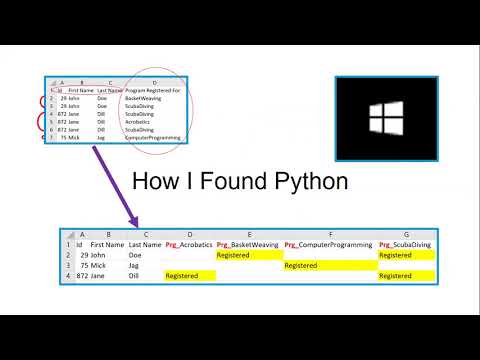Python for Spreadsheet Manipulation 101 - Hands-On Training for Salesforce Admins
Thanks for coding for THREE HOURS with me on a sunny Saturday!
Table of Contents
Homework
If I could give you one homework assignment, it’d be to get Python up and running on your computer.
If you can’t apply this to your real-world business problems, I’m going to cry.
And the number one thing that’s going to stop you isn’t lack of Python knowledge … it’s not having your tools “ready to go” when you think of a business problem you could solve using it.
Don’t make me cry.
- So your homework is to get an “IDE” set up and to copy/paste the “Hello World” program and the “read a CSV file off the internet and print stuff out about it” program onto YOUR computer, running them from there.
As soon as you have both of those code snippets up and running, the world is at your fingertips!
Tweet me when you get it – #AwesomeAdmin & #YayUs !
- For Windows computers on which I have “admin” rights to properly install software, I’ve really enjoyed working with “Anaconda,” which both installs Python plus its “Pandas” plugin on your computer (so that an IDE’s “run button” actually does something – your computer doesn’t come “out of the box” understanding Python code) and installs the “Spyder” IDE (the actual text-editor-with-run-button).
- For Windows computers on which I don’t have permission to install software, I’ve made good use of these directions for installing WinPython. Note that without administrator rights, you might not be able to update certain components of Windows to support the latest version of WinPython, which I address in the directions, but older versions of WinPython make your computer only understand commands from older versions of Python and its Pandas plugin, which might leave you Googling for how things “used to be done” in cases where the way Python code is written has gotten simpler and easier to use as time goes on.
- Some people also like PyCharm. (Definitely seems available for Windows & Mac…)
- Linux / Mac: I … don’t have either of those. Try Anaconda – it seems to be available for both.
DM me on Twitter if you get stuck.
Exercises We Did
Click here for the “Exercises” instructions
Slides PDF
Click here to download a PDF of the slides
Session Recording
IMPORTANT NOTE:
The links have changed! The links in the session recording are no longer guaranteed to be accurate! If they no longer work, or seem to be doing something different, it’s because I reused them for another presentation!
Replacement links are available with a “201810-“ after the “sfpy” but before the rest of the URL.
So …/sfpyhello becomes …/sfpy201810-hello and …/sfpyhello-b becomes …/sfpy201820-hello-b
(Click here for session video)
Further Resources
- Official documentation of Pandas commands
- Quick Examples of the sort that we went over in class, with a “homework” exercise for each problem
Door Prize Scripts
Hopefully you can use these at work yesterday.
Tweet me if you use these in real life – #AwesomeAdmin & #YayUs !
Duplicate Summarizer
This script, once you give it the location of your CSV file on line 3 and the the set of column names that make up your “duplicate matching key” on line 4, will tell you 5 useful things:
- How many rows are a “duplicate” of some other row
- How many “groups” of duplicates there are in your CSV file
- How many total rows there are in your CSV file
- What the “duplicated” rows say in them
- What the “nature of the groups” are (e.g. if you’re grouping on “FirstName” & “LastName,” a table showing you things like “John Smith,” “Jane Doe,” etc.)
import pandas
pandas.set_option('expand_frame_repr', False)
filename = 'c:\\example\\sample.csv' # Edit this before running
dupeColumns = ['col1','col2','col3'] # Edit this before running
df = pandas.read_csv(filename, dtype=object)
isDupeSeries = df.duplicated(dupeColumns, keep=False)
isFirstDupeSeries = df.duplicated(dupeColumns, keep='first')
print(str(isDupeSeries.sum()) + ' dupes in ' +
str(isFirstDupeSeries.sum()) + ' groups in ' +
str(len(df)) + ' rows')
print('\r\n---The duped rows are:---')
print(df[isDupeSeries])
print('\r\n---The "dupe keys" are:---')
print(df[isFirstDupeSeries][dupeColumns])
